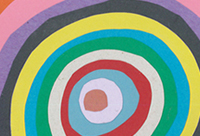What Is Color?

It’s possible to view color as all these things and more besides. Color is complicated. Here, we’ll take a look at a few key aspects of color.
Color Is Transmitted by Light
We know from Isaac Newton’s seventeenth-century prism experiments that “white light” from the sun can be separated into a rainbow of colors and recombined into white light. In the nineteenth century, we learned from James Clerk Maxwell that the light we see—the visual spectrum—is a small part of a huge, vibrating electromagnetic field that ranges from short-wavelength gamma rays to long-wavelength radio waves. The range of waves is continuous, although we’ve found it useful to divide the spectrum into various regions. You can see the wavelengths and associated colors of the visual spectrum in the graph below.

The colors associated with the visual spectrum; wavelengths are approximate.
When an opaque object is illuminated, it generally absorbs some of the wavelengths of light that fall on it and reflects others. Scientists can measure wavelengths of reflected light quite precisely. Here at the Exploratorium, we used a digital spectroscope outdoors on a sunny afternoon to measure the wavelengths of light reflected by a red rose. The graph below shows the results from the spectroscope.
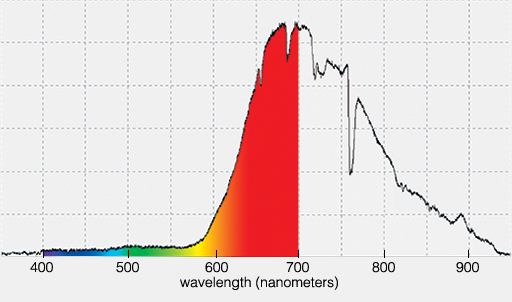
This graph shows the results from a spectroscope measuring the light being reflected by a red rose. Almost all the visible light reflected is red. The uncolored part of the graph past 700 nanometers shows that the rose also reflected infrared radiation.
Color Is a Matter of Perception
The retina at the back of your eye contains rod-shaped and cone-shaped
photoreceptors
, or light-sensitive cells. The rod-shaped cells are extremely sensitive to light. They help you see in near darkness, but the information they send to your brain along the optic nerve only lets you see lighter or darker shades of gray.
In brighter light, the cone-shaped cells take over, allowing you to perceive color. There are three types of cone cells: The first type (L) responds most to long-wavelength light, the second type (M) responds most to medium-wavelength light, and the third (S) responds most to short-wavelength light. The brain integrates and interprets information from the cones that have been stimulated and determines the colors we perceive.
If you’d been nearby while we were measuring the wavelengths of light being reflected by our rose, the petals would have stimulated your long-wavelength cones the most (if you have normal color vision), and you’d have perceived the petals as red—very much in accordance with our measurements.
Curiously, though, you may perceive colors that don’t match a scientist’s measurements. Consider this: A combination of red and green light will lead you to perceive yellow. You can experience this at the Exploratorium exhibit called Seeing Yellow. On one side of the exhibit there’s a pure yellow light, and on the other side, red light and green light are combined into one beam. When the yellow light and the combined red-green light shine on strips of plastic, the colors look the same. Because human cones can’t tell the difference between the yellow light and the mixture of red plus green light, we see them as identical colors, even though a spectroscope and many animals with different cones could easily tell them apart. Whenever you see yellow on a television or computer display, you’re actually seeing a mixture of red plus green light. TVs and computers have only red, green, and blue light to work with.
Color Is Personal
Another Exploratorium exhibit is called Disagreeing about Color. Eleven dots of light surround a central dot, and visitors are asked to choose the dot that most closely matches the central one.
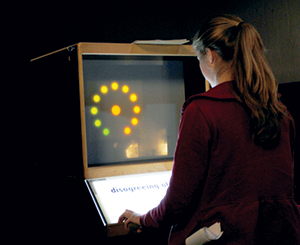
The exhibit Disagreeing about Color.
Try this when you’re in the museum, preferably with several other people, and you’re likely to find that not everyone agrees because everyone’s eyes are slightly different. A light-sensitive pigment in the macula lutea , a small oval spot in the center of the retina, absorbs some of the incoming light. This pigment varies in amount from person to person and can account for disagreement about color.
Pigments in the cones can vary as well. And, as people get older, the lenses of their eyes transmit less short-wavelength light to the retina, which can cause them to disagree with younger folks about some colors. So the next time you say something like “Please give me the blue book,” think about this: Although you and the person handing you the book may concur that the book is blue, you’re probably not seeing exactly the same color.
Color Is Relative
We don’t perceive colors in an absolute sense (although it may seem that we do). Instead, we see them in relation to adjacent colors, an effect called
simultaneous color contrast
. The juxtaposition of colors enhances their differences. If, for example, chartreuse is on a green background, it looks more yellow; on a yellow background, more green.
Color contrast is most noticeable when complementary colors are involved. (Complementary colors are two colors of light that, when added together, make white.) Yellow, for instance, looks brightest on a background of blue, which is its complement. In addition, when a color is next to another, it tends to induce its complement in the adjacent color, so the adjacent color acquires a slight tinge. Color contrast effects have been exploited by artists—notably the Impressionists, Postimpressionists, and in Op Art—to create many of the characteristics that distinguish those genres.
You can find approximate complementary colors by using one of the many color wheels available in encyclopedias and on the Web. But you can get a more exact result by seeing the afterimage of a particular color. An afterimage is an example of successive contrast , an effect similar to simultaneous contrast, in which color appearance is affected by a previously viewed color. See the Try This ! to explore this phenomenon.
Color Is in Your Head

We don’t perceive what we see—the light detected by our eyes—we perceive what we think: Our minds compensate to a great extent for changes in illumination, a phenomenon known as color constancy . And unless we’re trying to paint a picture, that’s a good thing. Life would be very confusing if things seemed to be always changing their colors as they moved or as the light changed. We have a basic need to identify things in our environment quickly, and color constancy helps us do that. Our ancestors survived, in part, because they could recognize both predators and prey under different lighting conditions.
What’s Happening?
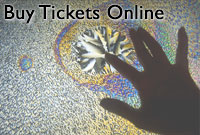
Buy your General Admission tickets ahead of time!
(415) 561-0362.
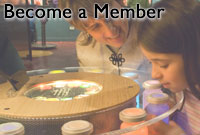
Members receive free admission every day, along with many other benefits!
Find out more .
Visit Our Online Store




